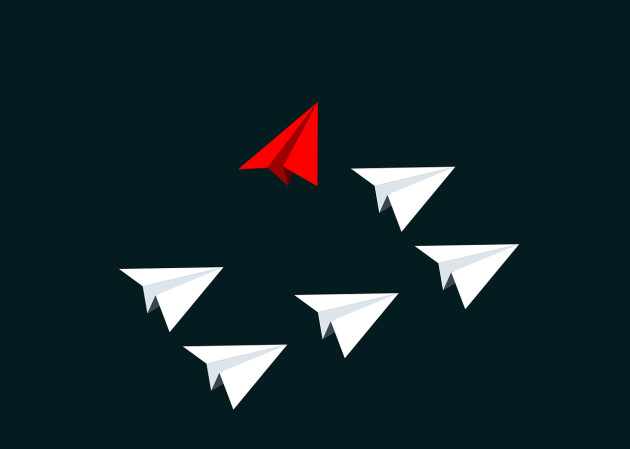
Jerry Lockspeiser: Do we have the courage to change?
It’s the time of year for reflection – on what has passed and what might come. Brexit, Covid, war in Europe, and the multiple consequences of the cost-of-living crisis cast a negative shadow. We might feel paralysed, ready to draw in our horns. Yet, two famous quotes point us towards positive thinking.
Entrepreneurs know the truth of Albert Einstein’s statement that “In the midst of every crisis lies great opportunity.” Or as expressed in Churchill’s call to action: never waste a good crisis.
This advice is often easier said than done. Behavioural economics observes that negative factors have much greater weight on our instinctive attitudes than positive ones. Most people prioritise behaviour that reduces the risk of losses, rather than behaviour that increases the chance of gains.
When business is tough the knee jerk reaction is to cut costs in a bid to preserve profits, or at least to limit how much they decline. Marketing budgets are often first on the cull list, followed by staff. But the smarter move may be to do the opposite; to spot an opportunity amongst the market mayhem and increase marketing spend and people resource to grab it. Bold, front foot moves take vision, nerve, self-belief, and clarity of what may be possible – and what not. No one wants to make a seriously expensive error of judgement.
This brings to mind the famous serenity prayer of American theologian Reinhold Niebuhr: “Grant me the serenity to accept the things I cannot change, the courage to change the things I can, and the wisdom to know the difference.”
Often used in reference to addicts in recovery, notably Alcoholics Anonymous – and thus particularly pertinent to the inherent hazard of our trade – it seems of timely relevance in a business context. Perhaps the key point is the last: to know the difference between what we can and cannot change.
Most of us in the wine trade cannot change many of the supply side issues we face – energy prices, bottle shortages, 10% plus inflation, lack of staff, logistical headaches and the rest. But the demand side is another matter. The ever astute and informative Richard Halstead of Wine Intelligence/IWSR pointed to the biggest challenge we face for the next year and beyond. His presentation ‘The battle of the generations’, made the crucial point that fewer and fewer young people in the UK are drinking wine, making it an old person’s tipple. In 2010, 37% of 18-39 year-olds drank wine regularly. Today that number is 26%. Half of all wine drinkers are over 55 years old.
It is a serious long-term issue we need to address if we are to have thriving businesses selling wine in future, but all is not doom and gloom. People are living longer, so the older cohort will be buying for a while, yet; younger people become older people and may yet switch to wine later in life (if they drink alcohol at all); those young people who do drink are much more ‘into’ wine and tend to spend more per bottle. And people in other parts of the world where wine was not historically a part of everyday culture are joining the party.
Yet the challenge to everyone involved in UK wine business is stark: how to reverse the decline in the number of people choosing to drink wine and the reduction in volumes sold. If we leave out those who don’t drink alcohol at all and focus on those who do but prefer something else, we at least have a theoretical chance. This is something we can change, not something we can’t.
We have got a little better over the past decade or so at thinking about the consumer and what they might care about when we conceive our brands and communication plans. But we are still a long way behind other categories (and behind the consumers themselves). How far behind varies considerably within the trade (this is definitely not one size fits all), but to engage seriously with this task we need to slay a few dragons for good.
Stop pretending that wine is a health product. It isn’t. It’s a serious health risk to some. We have myriad truthful ways to excite and engage people with our products. Falling back on such a spurious claim shows a paucity of communication ideas. Becca Yeamans-Irwin nails this discussion in her recent Meininger’s article.
Start recognising that the same wine tastes different in different contexts. A lot of work has been undertaken on this subject in the last 10 years or so by Charles Spence and others. At its simplest, the lovely wine we had on holiday is much less appealing when we drink it back home – not because it hasn’t travelled well, but because we aren’t on holiday. Our mood and experience when away enhanced our enjoyment. Susan Lin MW nails this point in a piece on timatkin.com about how different types of music affect people’s taste of wine.
Accept that the method of buying is more important than the product itself. Most people will no longer traipse around from shop to shop, website to website, or app to app to track down a specific wine. They buy what is available through their chosen method of shopping, and the easier that is the more likely they are to do it. This is especially true in the mass market where brand power is very weak and ‘infinite substitution’ between one Australian/Chilean/French Chardonnay and the next prevails. How people buy is now more important to what they buy than the inherent qualities of a wine.
Get used to the fact that most people have no interest in the detail of production methods. Some do, of course, and they will seek out that information. But most do not. Worse, reading about it can create a barrier that saps the confidence to buy. Not only the everyday supermarket or online shopper but also those who buy very expensive wines. Those committed to organic or natural wines have an interest at headline level, but how many want details beyond this philosophical reassurance?
Acknowledge that most consumers use non wine product cues to make their purchase decision. It’s got high ratings on Vivino; it’s on price discount offer; my friend told me its nice (or Tim Atkin recommends it); it’s the second cheapest on the restaurant list; I like the look of the label; it’s got a great story. A follow on to the previous point, we will be more successful in selling our products if we acknowledge these are the kind of areas that determine consumer behaviour.
Better and better wine is not the answer. Embrace Psychology. Explainers of behavioural science like Richard Shotton, author of The Choice Factory, are now as important to gaining competitive advantage and capturing sales as is the work of the winemaker. Psychology matters, a lot. It is probably no coincidence that sales of Portuguese wines in the UK have increased dramatically since the region called Extramadura re-branded as Lisboa. Wine margins do not generate the cash for marketing budgets that categories like spirits or perfume do, so nimble use of cheap but insightful methods to persuade people to buy are paramount – and available for free. Social media is a gift for the wine sector.
Does all this mean that the wine in the bottle is unimportant? Absolutely not. On the contrary, it is essential. People will not purchase something they don’t like a second time. However, most wine producers and blenders now know how to make a wine style that their target market will like. Most have scores of competitors with something very similar at around the same price. Having a wine that is suitable for its market gets you onto the starting grid but it doesn’t win the race. It is a necessary, but not sufficient, element of being successful.
To win back wine’s lost volumes, to excite and engage wine’s lost generation, we need to clear our minds of old ways, see things as they do, and go to meet them where they are. We need the courage to change what we can.
Jerry Lockspeiser donates his fee for this column to The Running Charity who work with homeless young people in the UK.
Keywords:
- waste
- action
- crisis
- advice
- positive
- economics
- negative
- behaviour
- easier
- behavioural
- albert einstein’s
- einstein’s statement
- crisis lies
- economics observes
- behavioural economics
- towards positive thinking
- positive thinking entrepreneurs
- people prioritise behaviour
- behavioural economics observes
- albert einstein’s statement









